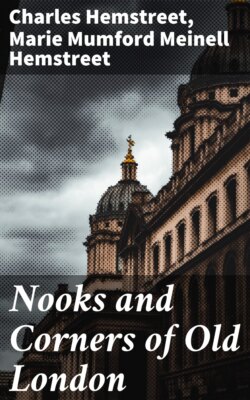Читать книгу Nooks and Corners of Old London - Charles Hemstreet - Страница 7
On the Way to Great St. Helen's
ОглавлениеThe eastern section of the General Post Office stands on the site of the ancient church and sanctuary of St. Martin's, commemorated in the street of St. Martin's-le-Grand. This sanctuary was the outcome of a very old custom—a place consecrated, where criminals who sought refuge within its precincts were protected from all law. The Sanctuary of St. Martin's was founded in the days of Edward the Confessor, and came to have a most unsavoury reputation, for the rights of sanctuary brought a great gathering of criminals of every sort and people of the lowest degree. Within the shelter of the Sanctuary of St. Martin's, Miles Forest, one of the murderers of the princes in the Tower, took refuge and finally died.
The quiet little garden beside the church of St. Botolph Without Aldersgate, was built over the graveyard that surrounded the church for more than half a century. The church has stood here since 1796, and the garden spot of to-day is called Postman's Park, because of the many employes from the nearby General Post Office who gather here.
A fragment of the wall that surrounded early London is to be seen in the northern boundary wall of the General Post Office, from Aldgate Street to King Edward Street.
The walls that encircled Roman London, built between 360 and 380, enclosed about 375 acres in its three miles of circumference, were twelve feet thick, twenty feet in height, with towers at stated distances twenty feet higher than the walls. It had its start near the spot where the Tower is now, and followed generally the line of the present streets of the Minories, Houndsditch, London Wall, and so on to Newgate, Old Bailey, Ludgate to the Thames. The wall was marked in later days by its chief gates—Ludgate, Aldgate, Cripplegate, Newgate, Bishopsgate and Aldersgate. Fragments of it are still to be seen in the street called London Wall, between Wood Street and Aldermanbury, where a tablet marks it; at St. Giles, Cripplegate, and in the boundary wall of the new Post Office from King William to Aldgate Street.
John Milton moved to the present Maidenhead Court from St. Bride's Lane. It was then called Lamb Alley, and is off Aldersgate Street to the east. This was his pretty garden house of which he often spoke. It was here he had a sort of private school where he educated the two sons of his sister and several children of his personal friends. Here, too, he married Mary Powell, who before long finding married life irksome, left her poet husband who even then was showing signs of the blindness that was soon to be his portion.
In Jewin Street, about the year 1663, Milton lived when he had been blind for ten years, and here he married Elizabeth Minshull, his third wife.
In the street called Barbican, off Aldersgate Street, Milton lived for two years after 1645, during which time he wrote "L'Allegro" and "Comus." He moved here that he might have a large house to accommodate the increasing number of pupils he had been educating in the Lamb's Alley house. Here his wife, who had deserted him, returned, and here his first child was born in 1646. In the narrow and winding roads hereabouts, the great plague of 1665 caused greatest havoc.
Redcross Street came by its name because of a cross that once stood where Beach Street touches Redcross.
In the green and quiet churchyard of St. Giles, Cripplegate, hemmed in by tall warehouses, is a part of the old Roman wall, possibly the most perfect bit that now remains. The church was built in the 14th century, but has been well taken care of and often restored. Cripplegate takes its name from "Crepel geat,"—a covered way or tunnel, which the Roman soldiery used when defending the city wall. It was in this church that Oliver Cromwell in 1620, when he was quite a young man, was married to Elizabeth Bourchier. Milton, who wrote "Paradise Lost" in a house in this parish, was buried here. In front of the chancel is a stone which reads:
Near this spot was buried
John Milton
Author of 'Paradise Lost,'
Born 1608. Died 1674.
Foxe, who wrote the "Book of Martyrs," is also buried here, together with Speed, the topographer, who died in 1629, and Sir Martin Frobisher, the voyager, who was buried in 1594.
Although the part of town about Milton Street is fitted with memories of Milton, this roadway was not named for him, but for a popular builder who lived here. This is the former Grub Street, which Dr. Johnson's dictionary speaks of as "inhabited by writers of small histories, dictionaries and temporary poems; whence any mean production is called Grub Street." Swift, writing of the street, said:
O Grub Street! how do I bemoan thee,
Whose graceless children scorn to own thee;
Yet thou hast greater cause to be
Ashamed of them than they of thee.
On one side of the church of St. Alphage, which was at first a leper hospital, there is yet to be seen a barred window through which the afflicted could look and could hear the service, though they were not permitted to enter the church. Across the road is a fragment of the old Roman wall, railed off and preserved, and with it a bit of the greensward that once formed part of the churchyard of St. Alphage.
